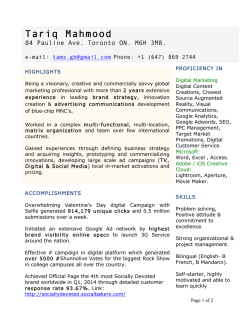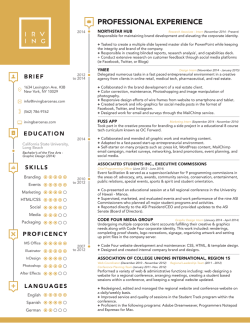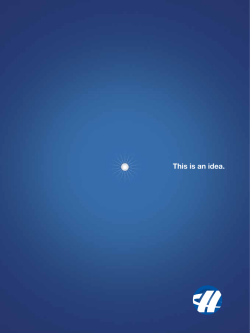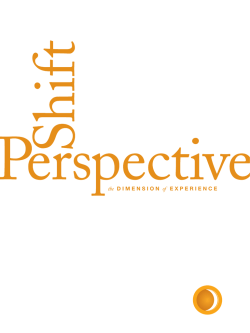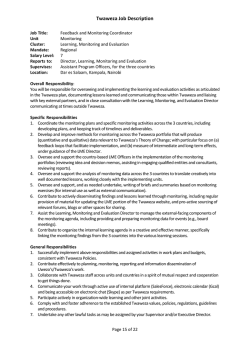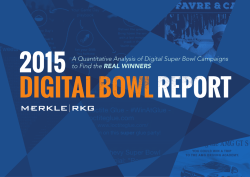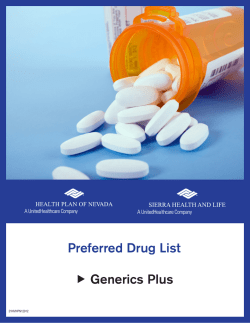
English 1115: Writing For The Web
Instructor: Barbara Myers Office: BIC 2406 E-Mail: [email protected] ENGLISH 1115 WRITING FOR THE WEB HYB01 REQUIRED TEXT: Felder, Lynda. Writing for the Web. Creating Compelling Web Content Using Words, Pictures and Sound. New Riders, 2012. Print. ISBN # 978-0-321-79443-7 (Recommended: A good dictionary and/or thesaurus) COURSE OVERVIEW: Facebook claims more than 1 billion active users as of 2012. As of 2015, Twitter reports 550 million tweets are sent per day. Approximately 350 million text messages are exchanged across the world’s mobile networks every month, and 145 billion emails are sent every day. Blogs are now considered an important part of a company’s online reputation with 60% of businesses now boasting a company blog. By the end of 2011, NM Incite, a Nielsen/McKinsey company, tracked over 181 million blogs around the world, up from 36 million in only five years. The evolution of search engines has also made the creation of unique content in a variety of media critical to improving visibility of brands and businesses online. In sum, the world of personal self-expression is now a vital piece of worldwide communication and, with increasing numbers of people engaged in the consumption and production of texts, an important part of the rapidly growing web. This dynamic transformation in how we communicate is generating new understandings of the power of the written word. English 1115 will enable students to explore writing in the digital age. Specifically, students will engage in digital formats that will allow them to become informed participants in online contexts, to shape their personal brand and be published. A hybrid course, English 1115 blends face-to-face meetings with online instruction. The course features guest speakers, professionals experienced in communicating in online contexts. Through practical application, students will learn to effectively: • • • • • Develop and support an online presence Build a personal brand Manage an online reputation Participate in an ongoing, real-world blogging project with publishing potential Apply web content and design fundamentals Coursework provides students with the opportunity to participate in a real-world blogging project that allows hands-on practice with web design, writing style, content and infrastructure optimization. Projects are designed to acquaint students with the principles and techniques of online communication grounded in the research that supports them. Emphasis is placed on user experience, online brand/tone/voice, content planning, website and social media interfaces. In order to understand the difference between writing for print versus writing for the web, students will examine reader behavior and explore how to accommodate the needs of online readers. Two assumptions will be key in this work: • • Writing and speaking are rhetorical – effective communicators must carefully consider their audiences and purposes as they plan, draft and revise their communications. Audiences differ in how they read and respond to communications – effective communicators must recognize and negotiate shifting demands in each new context. COURSE OBJECTIVES: In addition to opportunities to publish, upon successful completion of this course, the student should be able to do the following: • Understand how people read online vs. in print Examine user experience, active vs. passive reading behaviors Identify common online reading and scanning patterns Design for audience purpose Understand the writing and design relationship • Generate your online brand/tone/voice Develop and support an online presence Understand how your brand is perceived online Create a tone/look to fit your brand Understand how word choice and content structure affect how your brand is perceived Understand why establishing a personality, especially in social media, is critical to success • Apply rules for web writing Understand your audience and their limitations Use personas to inform content Address needs of both novice and expert users Measure readability and comprehension Create accessible, clear and concise content Use writing techniques to increase credibility Convert language to engage the audience Use and/or design effective visual elements • Apply best practices for formatting online content Set up and post content for website and social media types, including Twitter, LinkedIn, Blogs Prioritize information to increase visibility, improve scanning and comprehension Chunk content to reduce information overload Create titles that attract attention and help users find information Create headings and subheadings that encourage scrolling Write effective summaries for complex content Integrate hyperlinks that encourage clicks • Understand techniques for optimizing web content and design Repurpose print for the web Design content for scrolling Identify benefits of long pages vs. pagination Apply strategies for designing content text, images, audio, video Consider alternative ways to present information • Manage the writing process Integrate content strategy into a development process Define and apply a consistent voice, tone, and style to appeal to users Evaluate content
© Copyright 2025
